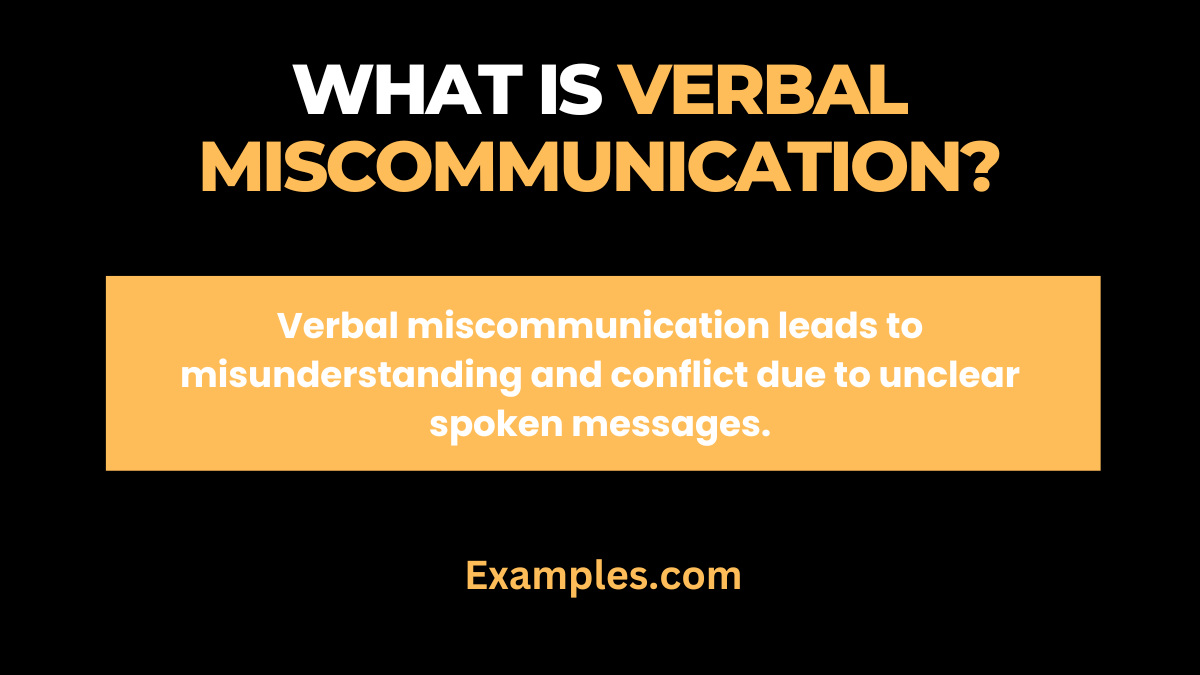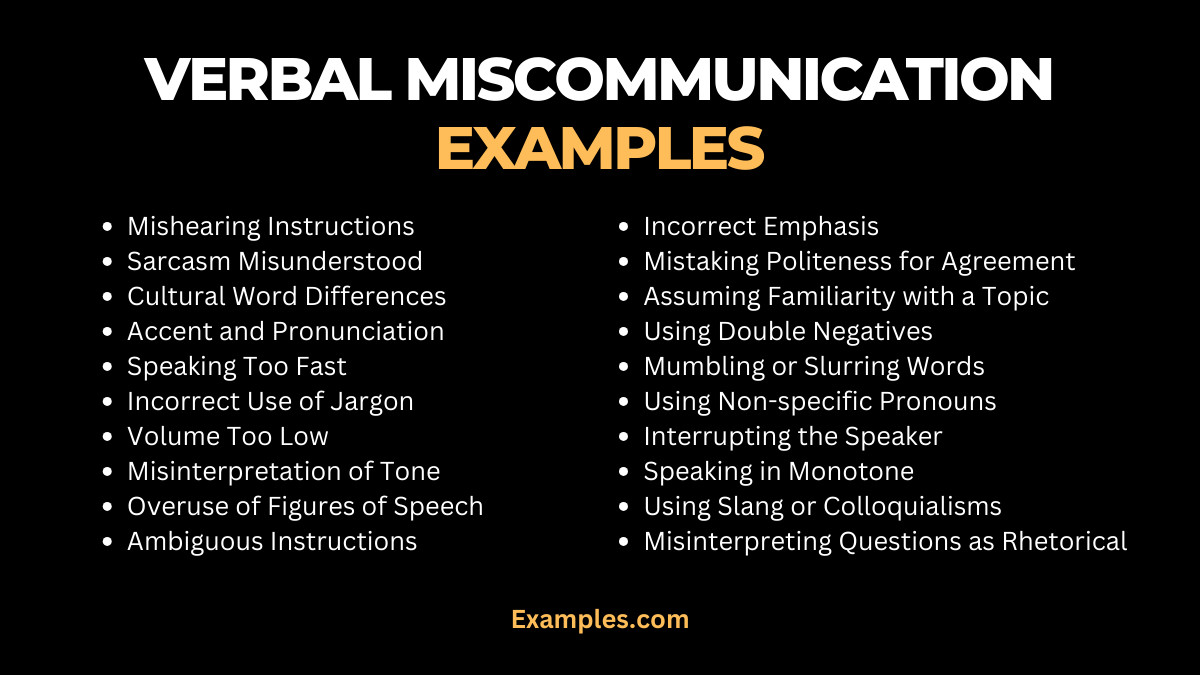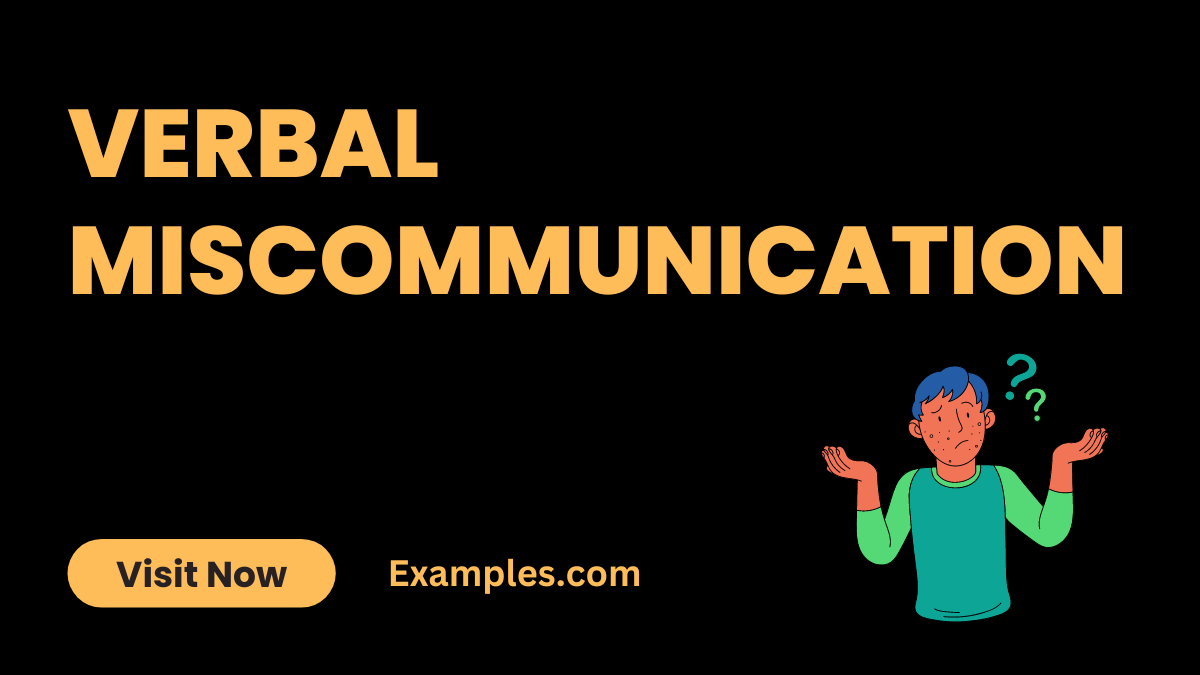14+ Verbal Miscommunication Examples
Verbal miscommunication, a common issue in both personal and professional settings, often stems from misunderstandings of tone, context, or word choice. This guide explores various miscommunication examples, providing insights into how easily words can be misconstrued. Understanding these nuances is crucial for effective communication, as the smallest misinterpretation can lead to significant consequences.
What is Verbal Miscommunication?

Verbal miscommunication occurs when a spoken message is misunderstood or misinterpreted. It can lead to confusion, conflict, and errors, especially in critical situations. Factors like tone, language barriers, and unclear phrasing often contribute to verbal miscommunication. Understanding and addressing this issue is vital for effective communication in personal, professional, and social settings.
15 Verbal Miscommunication Examples

Verbal miscommunication occurs when spoken words are misunderstood or misinterpreted, leading to confusion and potential conflicts. It’s a common issue in daily interactions, often resulting from differences in tone, context, or cultural nuances. Being aware of these pitfalls is crucial in enhancing effective communication. Here are 20 unique and distinct examples of verbal miscommunication, each accompanied by a brief explanation and example sentences to illustrate better communication.
- Mishearing due to Background Noise: In a noisy environment, someone might mishear instructions. Example: “I said ‘ship’, not ‘skip’ the order!”
- Using Jargon in General Conversations: Utilizing technical terms with a non-specialist audience. Example: A doctor using medical jargon with a patient, leading to confusion.
- Misinterpreting Tone: Taking a sarcastic comment seriously.
Example: “Sure, I loved that movie,” said sarcastically, but taken as genuine praise. - Language Barrier: Misunderstanding due to non-native language proficiency.
Example: A French speaker using an English idiom incorrectly, causing confusion. - Overly Complex Explanations: Using complicated language when simplicity is needed.
Example: Explaining a simple concept in a convoluted way, causing misunderstanding. - Incorrect Use of Words: Misusing words that sound similar.
Example: “Please accept my ‘condolences’ instead of ‘compliments’ on your work.” - Skipping Key Information: Assuming the listener has prior knowledge.
Example: Giving directions without mentioning a crucial turn. - Rapid Speech: Speaking too quickly for comprehension.
Example: A fast-talking salesperson confuses the customer. - Ambiguous Phrasing: Using unclear or vague language.
Example: “We might consider your proposal,” leading to uncertainty about the decision. - Interrupting the Speaker: Not allowing someone to finish their thought.
Example: Jumping to conclusions before the speaker completes their point.

- Cultural Misinterpretation: Phrases misunderstood across cultures.
Example: An idiom familiar in one culture confuses someone from another culture. - Emotional Miscommunication: Letting emotions distort the message.
Example: Anger making a request sound like a threat. - Underestimating the Audience’s Knowledge: Simplifying too much for an informed audience.
Example: Basic explanations to experts leading to belittlement. - Non-Listening: Formulating a response before fully hearing the question.
Example: Misinterpreting a question due to preoccupied thinking. - Using Generalizations and Stereotypes: Overgeneralizing a group or situation.
Example: “All teenagers are reckless,” leading to false assumptions.
The Importance of Verbal Miscommunication
- Prevents Misunderstandings: Clear verbal communication eliminates the risk of misinterpreting messages, which is crucial in maintaining effective personal and professional relationships.
- Enhances Clarity and Precision: Accurate verbal communication ensures that the intended message is conveyed, reducing errors in tasks and decision-making processes.
- Builds Trust and Credibility: Consistently clear and precise communication fosters trust among peers, colleagues, and clients, enhancing overall credibility.
- Facilitates Efficient Decision Making: When messages are conveyed accurately, it speeds up the decision-making process, as less time is spent clarifying or rectifying misunderstandings.
- Improves Interpersonal Relationships: Effective verbal communication leads to better understanding and empathy, strengthening personal and professional bonds.
What Technique Eliminates Verbal Miscommunication
- Active Listening: Engaging fully with the speaker, acknowledging their message, and clarifying any ambiguities can significantly reduce verbal miscommunication.
- Clear and Concise Language: Using simple, direct language and avoiding jargon or ambiguous terms ensures that the message is easily understood.
- Feedback Loops: Encouraging feedback to confirm understanding can prevent misinterpretation of the spoken message.
- Emotional Awareness: Being aware of one’s tone and emotional state while speaking helps in delivering the message more effectively.
- Cultural Sensitivity: Understanding and respecting cultural differences in communication styles can greatly reduce misunderstandings in diverse environments.
What is the most common reason for miscommunication?
- Assumptions: Assuming the other person has the same knowledge or context leads to gaps in communication.
- Lack of Clarity: Failing to articulate thoughts clearly is a primary cause of verbal miscommunication.
- Distractions: External distractions or mental preoccupation can result in not fully grasping the spoken message.
- Emotional Influence: Emotions can distort both the delivery and interpretation of verbal communication.
- Cultural Differences: Varied cultural backgrounds can lead to different interpretations of the same verbal message.
In conclusion, verbal miscommunication can arise from a myriad of factors ranging from tone variations to ambiguous language. These examples highlight the importance of clear, concise communication in avoiding misunderstandings. To prevent these issues, it’s crucial to consider context, choose words carefully, and seek clarification when in doubt. Remember, effective communication is key to reducing the frequency and impact of miscommunication in our daily interactions.



